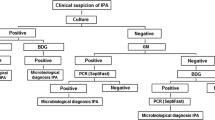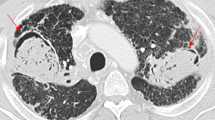Summary
Pulmonary mycoses, such as invasive aspergillosis are a major threat for immunocompromised patients. Non-aspergillus mould infections of the lung are still rare but increasingly observed. Pulmonary Candida infections are also rare. Other fungal infections that can affect the lung are cryptococcosis, and endemic mycoses such as blastomycosis, histoplasmosis, coccidioidomycosis and paracoccidioidomycosis. The diagnosis of pulmonary fungal infections is difficult and may therefore frequently be delayed or even missed. Computer tomography and microbiology are the most important diagnostic approaches. Discrimination between colonization and invasive infection is a particular challenge. Antigen detection and polymerase chain reaction (PCR) are additional valuable diagnostic tools. Amphotericin B has been the drug of choice for decades. The armamentarium has been enlarged by the introduction of less toxic amphotericin B lipid formulations, of broad spectrum azoles such as voriconazole and posaconazole and of the echinocandins (caspofungin, anidulafungin and micafungin) into therapy. Voriconazole has demonstrated efficacy in the treatment of invasive aspergillosis and is now licensed for first-line treatment together with amphotericin B. Lipid formulations of amphotericin B are an option, particularly for empiric treatment. Posaconazole is also reported to be active against various emerging opportunistic moulds such as Fusarium species and Zygomycetes. Caspofungin is licensed for second-line therapy of invasive aspergillosis. Along with the antimycotic spectrum, the pharmacokinetic properties and the toxicity of antifungal drugs are crucial for therapeutic success.
Similar content being viewed by others
References
Meersseman W, Lagrou K, Maertens J, et al. Invasive aspergillosis in the intensive care unit. Clin Infect Dis 2007;45:205–16
Kullberg BJ, Oude Lashof AM. Epidemiology of opportunistic invasive mycoses. Eur J Med Res 2002;7:183–91
Kontoyiannis DP, Lionakis MS, Lewis RE, et al. Zygomycosis in a tertiary-care cancer center in the era of Aspergillus-active antifungal therapy: a case-control observational study of 27 recent cases. J Infect Dis 2005;191:1350–60
Ascioglu S, Rex JH, de Pauw B, et al. Defining opportunistic invasive fungal infections in immunocompromised patients with cancer and hematopoietic stem cell transplants: an international consensus. Clin Infect Dis 2002;34:7–14
Eriksson U, Seifert B, Schaffner A. Comparison of effects of amphotericin B deoxycholate infused over 4 or 24 h: randomised controlled trial. BMJ 2001;322:579–82
Boswell GW, Buell D, Bekersky I. AmBisome (liposomal amphotericin B): a comparative review. J Clin Pharmacol 1998;38:583–92
Bellmann R, Egger P, Wiedermann CJ. Differences in pharmacokinetics of amphotericin B lipid formulations despite clinical equivalence. Clin Infect Dis,2003;36:1500–1
Vogelsinger H, Weiler S, Djanani A, et al. Amphotericin B tissue distribution in autopsy material after treatment with liposomal amphotericin B and amphotericin B colloidal dispersion. J Antimicrob Chemother 2006;57:1153–60
Vermes A, Guchelaar HJ, Dankert J. Flucytosine: a review of its pharmacology, clinical indications, pharmacokinetics, toxicity and drug interactions. J Antimicrob Chemother 2000;46:171–9
Lomaestro BM, Piatek MA. Update on drug interactions with azole antifungal agents. Ann Pharmacother 1998;32:915–8
Jeu L, Piacenti FJ, Lyakhovetskiy AG, et al. Voriconazole. Clin Ther 2003;25:1321–81
Herbrecht R, Denning DW, Patterson TF, et al. Voriconazole versus amphotericin B for primary therapy of invasive aspergillosis. N Engl J Med 2002;347:408–15
Capitano B, Potoski BA, Husain S, et al. Intrapulmonary penetration of voriconazole in patients receiving an oral prophylactic regimen. Antimicrob Agents Chemother 2006;50:1878–80
Wagner C, Graninger W, Presterl E, et al. The echinocandins: comparison of their pharmacokinetics, pharmacodynamics and clinical applications. Pharmacology 2006;78:161–77
Bellmann R. Clinical pharmacokinetics of systemically administered antimycotics. Curr Clin Pharmacol 2007;2:37–58
Author information
Authors and Affiliations
Corresponding author
Rights and permissions
About this article
Cite this article
Bellmann, R., Bellmann-Weiler, R. & Weiler, S. Pulmonary mycoses. memo 1 (Suppl 3), 15–19 (2008). https://doi.org/10.1007/s12254-008-0045-y
Received:
Accepted:
Issue Date:
DOI: https://doi.org/10.1007/s12254-008-0045-y




